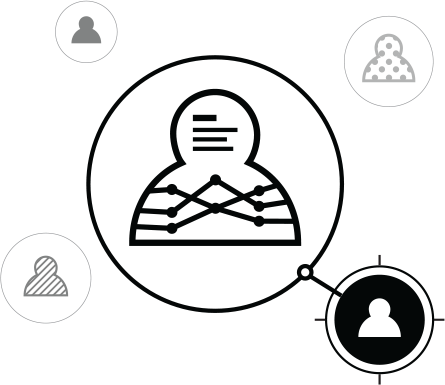Think about this common scenario.
You’re considering an upcoming trip to New York. You begin researching places to visit and travel options. You spend time on an airline website exploring ticket prices for specific dates. In short, your digital footprint has sent clear signals that you could be a motivated buyer. That airline knows your intent. It has access to data points that indicate:
- Who you are
- What travel destinations you’ve researched
- Where you live
- When you might want to go
- Perhaps even why you’re taking the trip – business or pleasure
 All of that information is readily available and can be used to find a compelling ad creative tailored to a market of one: You. This gives businesses a far higher likelihood of capturing the attention of busy people and converting them from a mere shopper to a loyal customer. Consumers favor it too, as a 2016 survey found that 78% prefer personalized ads, but in reality only 28% believe the ads they are served are actually relevant.
All of that information is readily available and can be used to find a compelling ad creative tailored to a market of one: You. This gives businesses a far higher likelihood of capturing the attention of busy people and converting them from a mere shopper to a loyal customer. Consumers favor it too, as a 2016 survey found that 78% prefer personalized ads, but in reality only 28% believe the ads they are served are actually relevant.
So, the obvious question is this: Why doesn’t that airline do it? More broadly, why aren’t all brands harnessing the full capability of their DMPs to deliver perfectly personalized ads?
The fast-evolving advertising technology landscape is complicated and even a little intimidating. But this is the key: Data Management Platforms have become part of the backbone of data-driven advertising and marketing strategies with a 90% adoption rate among enterprises. DMPs are used to collect, organize and activate the huge amounts of data available about consumers.
DMPs can:
- DISCOVER: Gain insights about audiences, and identify new potential consumers
- TARGET: Extend campaigns using programmatic buying to put targeted messaging directly in front of optimal audiences
- ENGAGE: Create more sophisticated campaigns across various touch points and multiple channels to deliver messaging that speaks to individuals
 But while brands may know more than ever about potential customers, how do they activate it in a meaningful way? DMPs can provide a more systematic way to do programmatic marketing and data management, but the reality is that businesses are falling short in utilizing the full potential of DMPs, said Matt Lohman, the Senior Vice President of Sales at Jornaya.
But while brands may know more than ever about potential customers, how do they activate it in a meaningful way? DMPs can provide a more systematic way to do programmatic marketing and data management, but the reality is that businesses are falling short in utilizing the full potential of DMPs, said Matt Lohman, the Senior Vice President of Sales at Jornaya.
At the recent AdExchanger Programmatic I/0 conference in San Francisco, Google Vice President of Media Platforms Sean Downey told the audience that the No. 1 issue currently facing brands is that they spend time and money to identify audiences, but don’t know which creative to serve those audiences. Brands, he concluded, are wasting resources.
RevJet helps brands change the way they market by unlocking the hidden potential in digital ad creative. RevJet helps advertisers activate their DMP’s data in ways they never imagined.
“Businesses already have spent all of this money not just buying the DMP, but getting the data integrated and organized,” said Adam New-Waterson, Vice President of Demand Generation at RevJet. “But then it’s a case of: What do I do with the data? How do I activate all of that DMP data to deliver relevant messages that connect with prospects and reconnect with customers?”
One of RevJet’s clients is a great example of this. Instead of targeting the same generic messaging, the tire and automotive services brand uses RevJet technology to market to an audience of one through a combination of dynamic content and customer information stored in the DMP. Data points for digital ads include:
- Who is a customer and who is a prospect
- If they in consideration for coupons
- Whether they own cars, trucks or SUVs
- If they tire buyers or looking for services
- Are the services that customers need oil changes, brake repairs, etc.
- If they trying to book an appointment
- The current weather of their market
- Their current physical location
 The client takes rich consumer information housed within the DMP, and constructs an intriguing message just for an individual viewer – all in real time.
The client takes rich consumer information housed within the DMP, and constructs an intriguing message just for an individual viewer – all in real time.
So let’s say a truck owner in Minnesota is exploring the website in October. He or she can be presented with an image of a winter setting and messaging for a discount on snow tires. A sports car owner in Miami checking out the cost of a tuneup at the same time? Show them offers and images of sleek automobiles speeding past palm tree filled beaches.
“This is a great example of what’s possible,” Serge Ioffe, CTO at RevJet, said. “The client is talking to their audience along a myriad of different dimensions. They’re taking into account all customer behavior on their site and creating a different value prop for each person.”
So, will you dream what’s possible and fulfill the creative promise within your reach? Or, will you continue to do what always has been done?
Download the full version of this white paper here.




